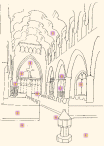
 |
  |
In the Middle Ages wall painting was a common decoration
of churches. Painting was prevalent because of its low cost, as opposed
to stained glass or sculpture, At the same time; wall paintings were also
the most vulnerable. Painted colors fade and the plaster surface deteriorate.
The extensive paintings of the nave in Pickering's
parish church in North Yorkshire show a typical placement. Opposite the
entrance porch, thus visible at first glance, are immense images of St.
George and St. Christopher. George defended against evil and
Christopher, striding through the stream with the Christ Child on his
shoulder, was the protector of travelers. Towards the east one sees the
Coronation of the Virgin by the Trinity set above
an image of John the Baptist at Herod's feast. Closest to the altar appear
the martyrdom of Thomas Becket at Canterbury and the Saxon king, St. Edmund
martyred by the Danes who transfix him with arrows.
On the south are stories of a more didactic nature. The area closest
to the altar is dedicated to a four level narrative of the Passion
of St. Catherine. The horizontal sequence stretching over the arches
shows the Works of Mercy followed by, and
After Henry VIII's break with the Roman church, paintings with their
"feigned" stories were systematically whitewashed.The paintings at Pickering
were discovered in the mid 19th century, and then covered over again by
a priest who found both their message and form unacceptable. In the late
19th century, a time of greater interest in the past as well as a more
ritualized church, local archeologists removed the whitewash. The restoration
of the paintings, following the ideas of the time, involved extensive infill,
particularly noticeable in the lower sections.
|